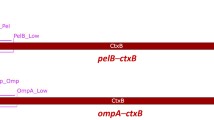Abstract
Cholera is an acute infection of the intestine caused by theVibrio cholerae bacterium. This bacterium, a member of Vibrionaceae family, is a facultatively anaerobic, Gram-negative, non-spore-forming curved rod, about 1.4–2.6 µm long, and capable of both respiratory and fermentative metabolism. Cholera, characterized by numerous voluminous watery stools, is often accompanied by vomiting (leading to bicarbonate loss). One of the most important virulence factors of cholera is enterotoxin (ctxAB). The cholera toxin beta subunit (CTB) is a pentameric non-toxic portion of V. cholerae toxin, responsible for holotoxin binding to the GM1-ganglioside receptor that is present on most nucleated cells. When conjugated to autoantigens, CTB dramatically increases its tolerogenic potential after oral administration. In the present study, the CTB gene from a hypertoxigenic V. cholerae strain was amplified and cloned. We first amplified the CTB gene with specific primers and the Prime STAR enzyme. The amplified CTB gene was then cloned in pET-28 vector and introduced into Escherichia coli DH5α. pET plasmids containing the CTB gene plasmids were then extracted from the bacteria and used to transform an expression host (BL21). After culturing and induction of positive bacteria, SDS-PAGE and Western blotting for protein determination and verification were performed. We also quantified the level of recombinant CTB by ELISA. Our results show that, due to its rapid growth, an expression host such as E. coli can be useful for production of CTB protein. The ELISA results showed yields of recombinant protein of up to 1 mg/L culture. However, optimal conditions for expression in our study included choice of host strain, temperature used for culture, and concentration of antibiotic and inducer. Beta subunit has many important scientific applications. There is a great deal of interest in the use of CTB as an adjuvant for vaccines targeted for delivery to the mucosa-associated lymphatic tissues. The importance and multifunctional nature of Beta subunit of V. cholerae enterotoxin, e.g., in oral vaccine preparation, will make the use of prokaryotic systems (such as Escherichia coli) for production of this protein most advantageous.


Similar content being viewed by others
References
Arzanlou M, Rezaee A, Shahrokhi N, Hossini AZ, Yasuda Y, Tochikubo K, Ahangarzadeh Rezaee M (2005) Expression of cholera toxin B subunit in Saccharomyces cerevisiae. Ann Microbiol 55(2):145–150
Bregenholt S, Wang M, Wolfe T, Hughes A, Baerentzen L, Dyrberg T, von Herrath MG, Petersen JS. The cholera toxin B subunit is a mucosal adjuvant for oral tolerance induction in type 1 diabetes. Scand J Immunol 57:432–438
Chinnapen DJ-F, Chinnapen H, Saslowsky D, Lencer W (2007) Rafting with cholera toxin: endocytosis and trafficking from plasma membrane to ER. FEMS Microbiol Lett 266:129–137. doi:10.1111/j.1574-6968.2006.00545
Cuatrecasas P (1973) Interaction of Vibrio cholerae enterotoxin with cell membranes. Biochemistry 12:3547–3558
Dawson RM (2005) Characterization of the binding of cholera toxin to ganglioside GM1 immobilized onto microtitre plates. J Appl Toxicol 25:30–38. doi:10.1002/jat.1015
Gong Z-H, Jin H-Q, Jin Y-F, Zhang Y-Z (2005) Expression of cholera toxin B subunit and assembly as functional oligomers in silkworm. J Biochem Mol Biol 38:717–724
Gong Z, Long X, Pan L, Le Y, Liu Q, Wang S, Guo J, Xiao B, Zhou M, Mei D (2009) Cloning, expression, purification and characterization of the cholera toxin B subunit and triple glutamic acid decarboxylase epitopes fusion protein in Escherichia coli. Protein Expr Purif 66:191–197
Goudarzi G, Sattari M, Habibi Roudkenar M, Montajabi-Niyat M, Zavaran-Hosseini A, Mosavi-Hosseini K (2009) Cloning, expression, purification, and characterization of recombinant flagellin isolated from Pseudomonas aeruginosa. Biotechnol Lett 31:1353–1360. doi:10.1007/s10529-009-0026-1
Kuziemko GM, Stroh M, Stevens RC (1996) Cholera toxin binding affinity and specificity for gangliosides determined by surface plasmon resonance. Biochemistry 35:6375–6384. doi:10.1021/bi952314i
MacKenzie CR, Hirama T, Lee KK, Altman E, Young NM (1997) Quantitative analysis of bacterial toxin affinity and specificity for glycolipid receptors by surface plasmon resonance. J Biol Chem 272:5533–5538. doi:10.1074/jbc.272.9.5533
Merritt EA, Sarfaty S, van den Akker F, L’Hoir C, Martial JA, Hol WG (1994) Crystal structure of cholera toxin B-pentamer bound to receptor GM1 pentasaccharide. Protein Sci 3:166–175. doi:10.1002/pro.5560030202
Merritt EA, Sarfaty S, Jobling MG, Chang T, Holmes RK, Hirst TR, Hol WG (1997) Structural studies of receptor binding by cholera toxin mutants. Protein Sci 6:1516–1528. doi:10.1002/pro.5560060716
Merritt EA, Kuhn P, Sarfaty S, Erbe JL, Holmes RK, Hol WG (1998) The 1.25 A resolution refinement of the cholera toxin B-pentamer: evidence of peptide backbone strain at the receptor-binding site. J Mol Biol 282:1043–1059. doi:10.1006/jmbi.1998.2076
Sack DA, Sack RB, Nair GB, Siddique AK (2004) Cholera. Lancet 363:223–233. doi:10.1016/S0140-6736(03)15328-7
Sun JB, Holmgren J, Czerkinsky C (1994) Cholera toxin B subunit: An efficient transmucosal carrier-delivery system for induction of peripheral tolerance. Proc Natl Acad Sci USA 91:10795–10799
Sun JB, Li BL, Czerkinsky C, Holmgren J (2000) Enhanced immunological tolerance against allograft rejection by oral administration of allogenic antigen linked to cholera toxin B subunit. Clin Immunol 97:130–139. doi:10.1006/clim.2000.4927
Vanden Broeck D, Horvath C, De Wolf MJS (2007) Vibrio cholerae: cholera toxin. Int J Biochem Cell Biol 39:1771–1775. doi:10.1016/j.biocel.2007.07.005
Author information
Authors and Affiliations
Corresponding author
Rights and permissions
About this article
Cite this article
Zeighami, H., Sattari, M. & Rezayat, M. Cloning and expression of a cholera toxin beta subunit in Escherichia coli . Ann Microbiol 60, 451–454 (2010). https://doi.org/10.1007/s13213-010-0062-z
Received:
Accepted:
Published:
Issue Date:
DOI: https://doi.org/10.1007/s13213-010-0062-z




